The packaging of electronic products is an important issue for both manufacturers and retailers. The complexity of global supply chains means that once simple processes are becoming increasingly difficult.
Electronic products require meticulous packaging. Not only are they expensive, fragile, and susceptible to ESD. Therefore, it is crucial to use protective packaging to prevent mechanical and physical damage during transportation. In this article, we will cover all the basic information about electronic packaging.
1. What is electronic packaging?
Electronic packaging is the packaging display of advanced electronic and technology products that can take your electronic products to a whole new level. And provide functional and stylish electronic packaging solutions.
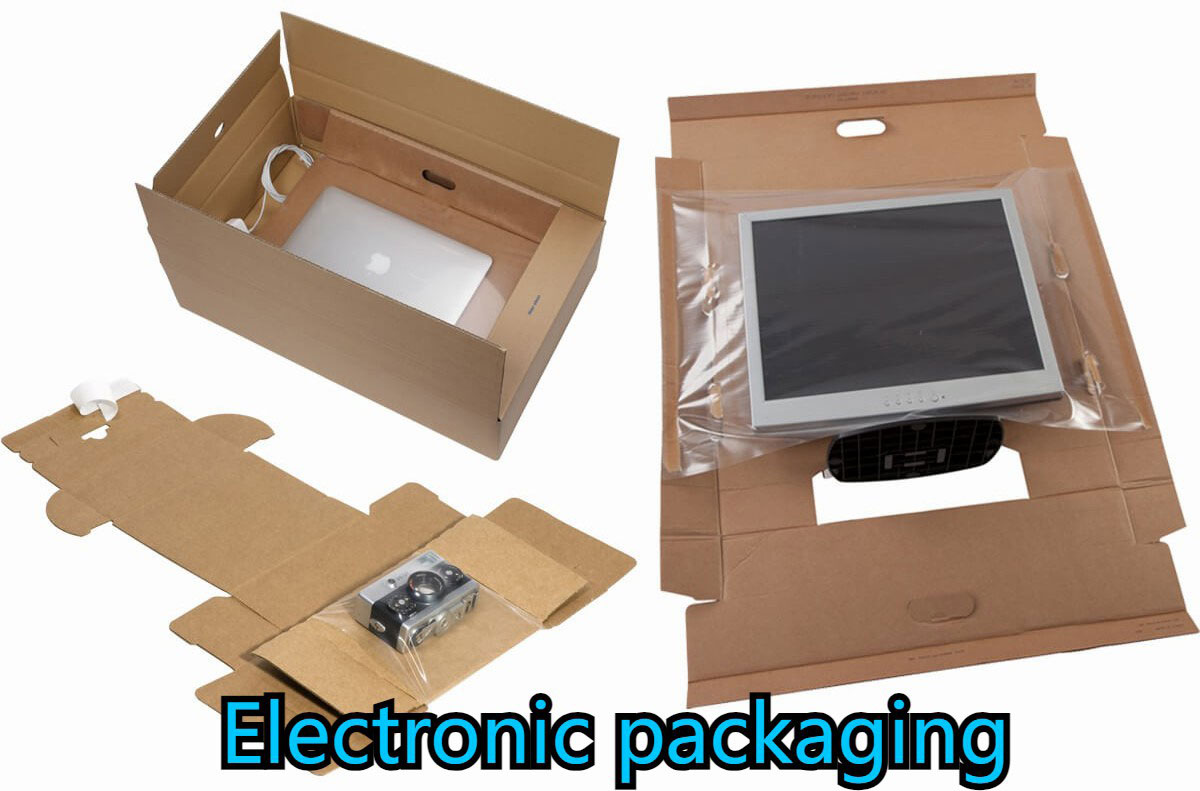
2. The importance of electronic component packaging
Taking the above factors into consideration, the development of the electronic manufacturing industry is obvious. face major challenges. Because electronics are fragile and costly, any damage to electronics during shipping can have serious consequences for a business’s financial health and reputation. Static electricity can also cause damage that may not be immediately noticeable. If a product won’t power on, doesn’t work properly, or lasts shorter than expected, the packaging solution is most likely to blame.
For example, I have a friend who is an iPhone wholesale supplier. The iPhone’s shipping packaging is very important to him. Because it’s about what the client thinks of him. Therefore, in order to achieve a successful packaging solution, it is necessary to ensure protection against impacts, moisture, misuse, dust, and static electricity during transport.
Two source factors of electronic packaging
Electronic packaging mainly stems from two factors: the rapid development of silicon IC (integrated circuit) technology and the continuous development of photonics. It is incorporated into different levels of interconnect in custom electronic packages. It requires electronic packaging strategies to constantly adapt and modify their capabilities to keep up with the changing technology landscape.
When it comes to photonics technology, physically connecting these electronic components to a printed circuit board can take designs to an advanced level. However, there are physical connections between these components and other basic functions in the system. It can press the schematic layout of the package (electronics).

3. Electronic component packaging type
The following are several types of electronic component packaging.
1) Tape packaging
It is the most well-known form of packaging for electronic components. It’s adaptable, efficient, and formalized. You can use this package style with all IC components except PLCC, QFP, and LCCC. There are three types of tape present in this package: plastic bag, paper tape, and surface mount tape.
You can use this tape to encapsulate chip resistors and capacitors. Plastic bags are used to package a variety of chip leadless components, composite components, special-shaped components, SOP, SOT, thin QFP, and other chip components. You can package resistors, diodes, capacitors, transistors, small ICs, crystal oscillators, and other chip components using tape and reel.
2) IC tube packaging
Can be used for rectangular chip capacitors, resistors, small devices, and some special-shaped components. It is ideal for small batch production of multiple SMT electronic components. When packaging, manage the parts in one direction and place them into plastic tubes. Next, insert stoppers such as plastic pins, nails, or rubber end plugs into each end of the line and remove the lid of the SMT box. Then, after the mounting process, when the tube is pressurized, the chip components are fed onto the substrate.
Tube packages can have higher material costs and may not be able to accommodate a large number of electronic components. Additionally, if the pressure distribution is uneven, there is a risk of trapping components within a confined space. However, for SM integrated circuits, tube packaging is cheaper than tray packaging. However, it is not as fast as carrier tape packaging.
3) Pallet packaging
Pallet packaging uses rectangular partitions to divide the pallet into equal parts according to the cavity. It also places components individually into each hole, averaging 50 pieces per pallet. After installation, cover the tray with protective film. Thermoformed pallets are available in single, ten-, three-, twenty- and twelve-ply four-ply pallet feeders. This method is initially suitable for tall, medium, and multilayer capacitors with larger shapes. However, you can also use them for packaged components such as QTPs and SOPs with many pins.
There are two types of pallet packaging: soft pallets and hard pallets. You can use hard pallets to package multi-pin and QTP components to prevent wire distortion. On the other hand, you can use floppy disk trays to package common odd-shaped components.
4) Bulk
Bulk packaging encapsulates chip components in plastic boxes/bags without any special arrangement. During installation, insert the plastic box into the material rack, and then use the feed tube to feed the components into the SMT machine material port. This method is low in cost and small in size but has a limited application scope.

4. Different levels of electronic component packaging
There are multiple levels of electronic packaging design, specifically from Level 0 to Level 5.
- Level 0 – In this layer of electronic packaging, the main focus is on protecting chips and semiconductors, which are basic and vital components of electronic setups.
- Level 1 – The goal of this level of electronic packaging is to protect electronic components from damage.
- Level 2 – PCBs are protected at this level of electronic packaging.
- Level 3 – In this level of electronic packaging, components, circuit boards, and their associated components are shielded and protected.
- Level 4 – Modules or groups of components are protected at this level of electronic packaging.
- Level 5 – At this level of electronic packaging, a mixture of various modules and some electronic systems are protected and protected.
These levels enable electronics manufacturing companies to easily identify the electronic packaging materials required for designs, simplifying operations and increasing efficiency. By specifying the current electronics packaging layer they are working on, they can quickly find the components they need.
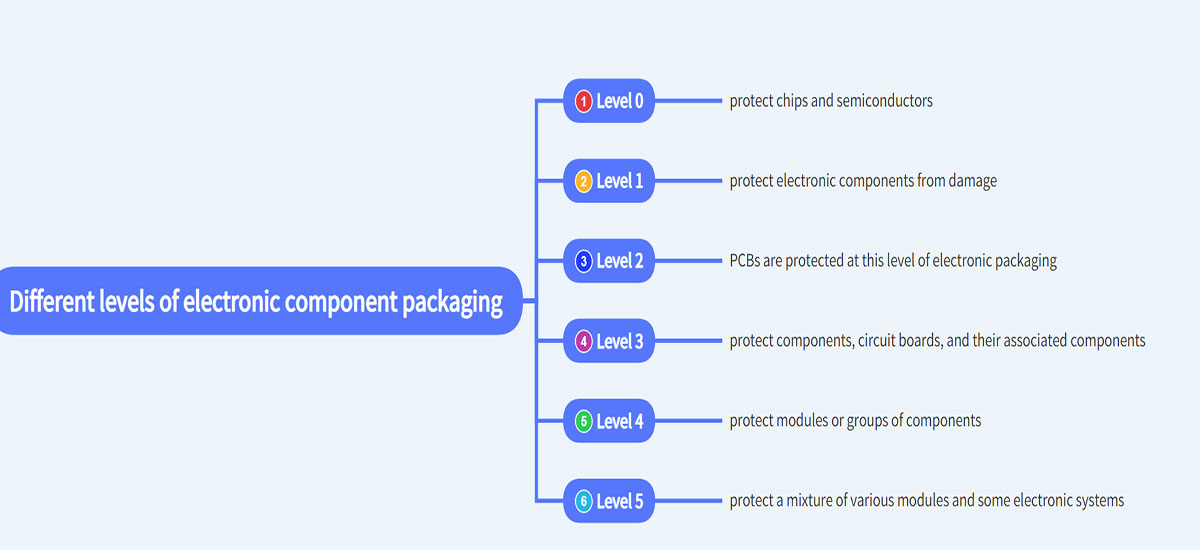
5. Important tips for electronic component packaging
Securing your package must be a top priority, especially when shipping fragile and valuable electronics. To avoid costly damage and returns, consider these simple tips.
- Secure batteries properly for transport – Many electronic products rely on batteries (either integrated or removable) to provide power. If not packaged correctly, these components can present a significant risk of generating dangerous heat, fire, or sparks during transportation. To prevent such events, all battery connectors must be protected from short circuits. One can achieve this by covering them with non-conductive insulating material.
- Separate wires and accessories – If the electronic product contains multiple components, it is recommended to keep them well organized within the packaging. Keeping accessories and cords separate is great for users because it prevents tangles, allows each component to be appropriately labeled, and enhances the overall customer experience.
- Use efficient shipping materials – Choosing the right materials is crucial to ensuring your electronics arrive in perfect condition. Void fillers and antistatic products are some of the options you can use to protect your products. You can keep them safe during transportation.
- Prevent and detect damage – Electronics are susceptible to damage during shipping, which can adversely affect your business due to their fragility and high cost. However, by leveraging impact signals, you can mitigate and detect defects during shipping to prevent losses. ShockWatch tags offer an excellent tamper-resistant solution. You can apply it directly to the package. They act as a visual deterrent to package handlers and provide physical evidence of between five and seventy-five impacts by releasing red dye. To learn more about impact metrics, see a recent case study in which these labels maintained high-tech equipment in a new situation.

6. Challenges faced by electronic component packaging
If your company produces or ships electronic components, then you know the importance of protecting these components during storage and transportation. Electronic components are highly susceptible to damage caused by oxygen penetration and other corrosive elements in the environment.
1) Packaging challenge
Choosing the right electronic component packaging that you can trust can be a difficult task. Buying inappropriate packaging can lead to costly waste and damage your company’s reputation, so of course you want to make sure you’re doing everything you can to protect your business assets.
In addition to this, component sizes vary and the shape is often irregular, which means that many standard packaging solutions are not suitable or up to the task of protecting precision electronic components. When you need to protect electronic components from electrostatic discharge, finding the right packaging can be more difficult.
2) Aluminum foil packaging
When it comes to protecting your electrical components from corrosion during storage or transportation to customers, aluminum foil may be the perfect solution. From the entire machine to the motherboard, you can give your equipment the protection it needs by choosing aluminum foil packaging, but what’s so special about it?
The main characteristics of aluminum barrier foil
Aluminum foil has many advantages that make it an excellent choice for your protective packaging needs. It has a low vapor transmittance and is equipped with the right amount of desiccant to provide the required protection against moisture and oxygen entry.
Aluminum foil protects against UV rays, oils, and other corrosive elements, reducing the need for expensive air-conditioned storage. The isolation foil is safe and reliable when sealed, providing clean packaging and protection throughout the product journey.

7. FAQs
Below are answers to frequently asked questions about electronic packaging.
1) What’s the best way to package electronic devices?
The best ways to pack electronics range from small devices and cables that require a simple bag or box to larger items like cameras and TVs. Product manufacturers protect products with durable bubble wrap before shipping to avoid the risk of damage during shipping. For smaller electronic smart products, it is recommended that you package the product in a nice, simple box that can be opened and closed easily. That is electronic packaging.
2) What are the best electronic packaging materials?
When it comes to the best materials for electronic packaging, it depends on the type of product you have. Different product types require corresponding electronic packaging materials. For equipment and installations, it is recommended that you use durable materials such as cardboard. Because cardboard protects your items better during shipping. For electronic smart products, it is recommended that you use environmentally friendly cartons and cans. But here’s something you need to know: Paper is more environmentally friendly than plastic.
3) What is an example of a good electronic package?
The packaging of the iPhone is an example of excellent electronic packaging. His sleek and simple, white and silver color scheme is striking and helps to convey the high quality of the product. The box is also designed to make it easy to open and use.
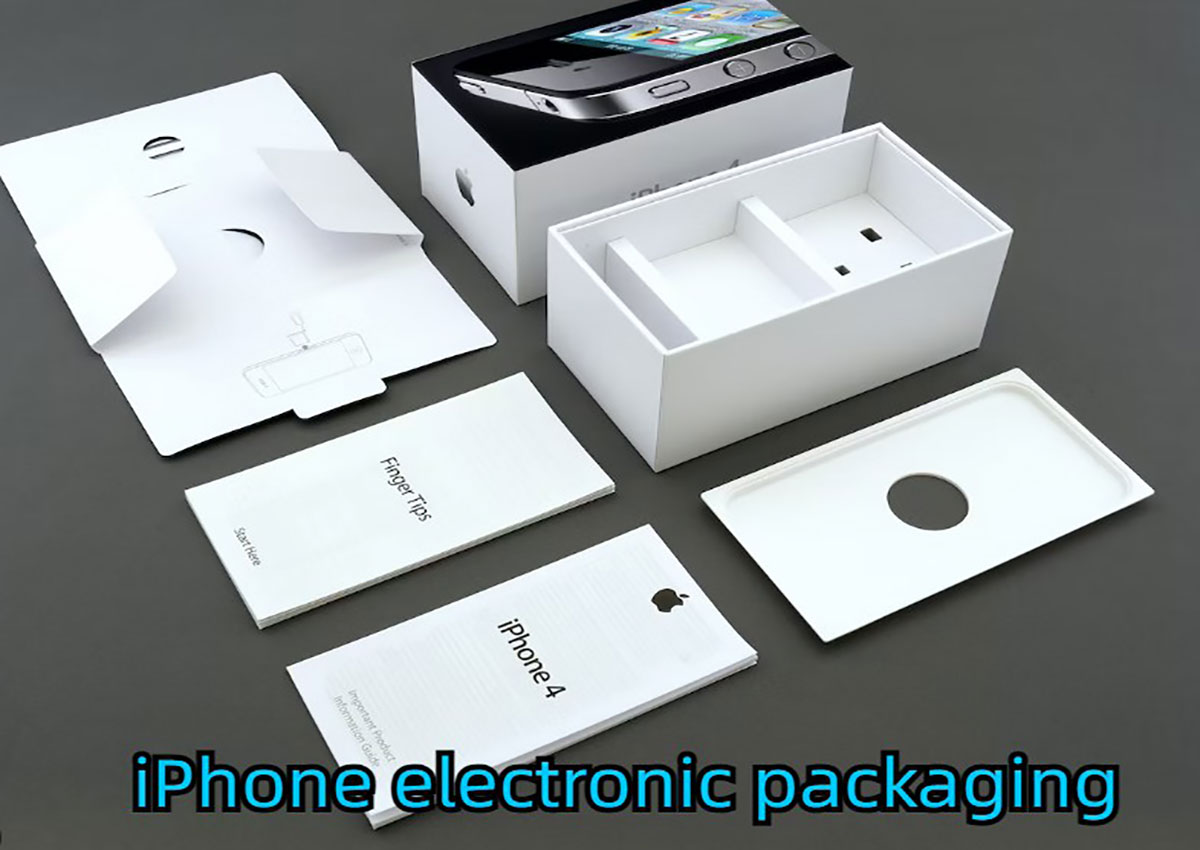
4) What should be included in electronic packaging?
There are a few key things to keep in mind when packaging electronics. That is the basic function of electronic packaging.
#1. Protection
Electronic products need to be adequately protected during transportation. Using sturdy packaging materials and boxes will help prevent damage.
#2. Easy to use
Electronic packaging should be easy to open and close, without confusing instructions or multiple steps.
#3. Storage
If possible, the package should also include storage space for accessories, cables, and other small items.
#4. Appearance
The packaging should be visually appealing, with clean lines and a modern design.
#5. Durability
The box must be sturdy to avoid bumps and scratches.
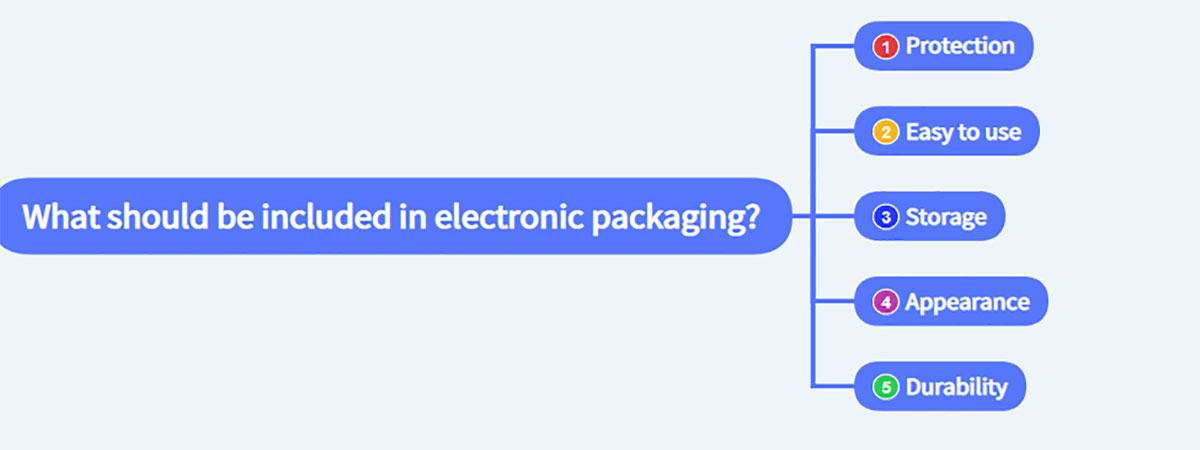
8. Conclusion
The above is the relevant knowledge of electronic component packaging introduced to you in this article. After reading this article, you will be able to choose the correct packaging for your electronic products. If you are looking for tube packaging for your electronic products, then contact Hopakpackaging and they will give you the perfect packaging solution.

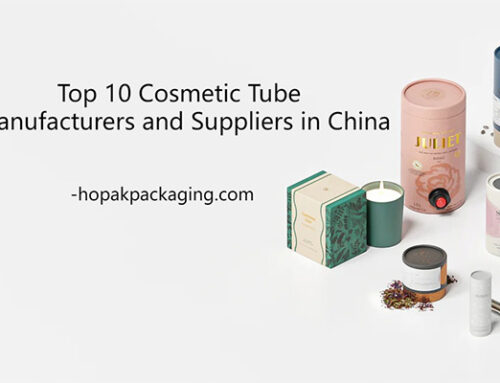
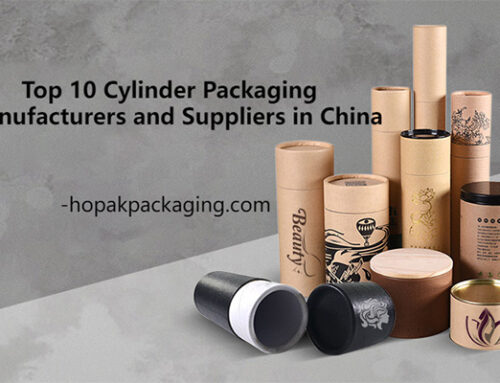



Leave A Comment